There are loads of towns in Tuscany.
And most of them would certainly qualify as beautiful.
Some are large towns such as Siena which is quite well-known.
Others are quaint villages and maybe not a town you’ve heard of such as Casole d’Elsa— which you’ll find out about soon enough.
Admittedly, Tuscany is über popular.
Finding beautiful towns is easy but finding a beautiful town that’s not so touristed is a bit more difficult.
I visited San Gimignano on my third visit to Tuscany.
I resisted because it’s on every tourist’s itinerary.
But I wanted to see what all the fuss was about.
While I did think it was beautiful, I thought other towns were equally so and less kitschy.
However, I always say that each person has to travel her own way — to find the places that resonate with you that YOU want to visit.
So below I compiled a list of 12 of the most beautiful towns in Tuscany.
Some I’ve been to and some I’m dreaming of traveling to — and are in my Location Inspiration Guide: A Journey Through Italy.
Some are pretty well-known and some not so much.
But I think this list is a wonderfully eclectic mix and I’m sure you’ll find a few that call to you.
Towns in Tuscany I’ve not visited yet (but that I really want to see!)
Montecarlo
This town is 12km east of Lucca —a bigger and more popular town that is also worthy of spending time.
But Montecarlo will get you away from the crowds.
Now this is not a town loaded with sites.
What you’ll find in Montecarlo is that slow, steady Italian — specifically Tuscan — way of life.
And, personally, I love wandering about towns where it’s mostly Italians going about their daily lives.
This walled city does have a few reasons to visit though.
The first is a fortress, known as the Rocca del Cerruglio, that was built between the 14th and 16th centuries that still stands and is quite impressive.
It’s composed of a main, semicircular-shaped tower — called the masito — and 2 square shaped towers — Torre dell’Apparizione and the Torre di Santa Barbara tower — which all form a grand triangular structure.
There are also a few churches worthy of some time with the Pieve di San Pietro being the most interesting.
Even though it’s been restored a few times, it’s quite old and really beautiful.
And if you’re into wine (ME!) you’re in luck as this area has its own DOC.
White wines made here are not only tasty —and often called the best in Tuscany — but unusual as they are made from Sauvignon Blanc, Semillon, Pinot Bianco versus more common Italian varietals such as Trebbiano and Malvasia.
While there aren’t a lot of places to stay right in town, you’ll find plenty of agriturismi (farmstays) nearby.
You won’t be spoiled for spots to eat in town as there are a nice array of restaurants, bars and pizzerias serving up delicious Tuscan specialties.
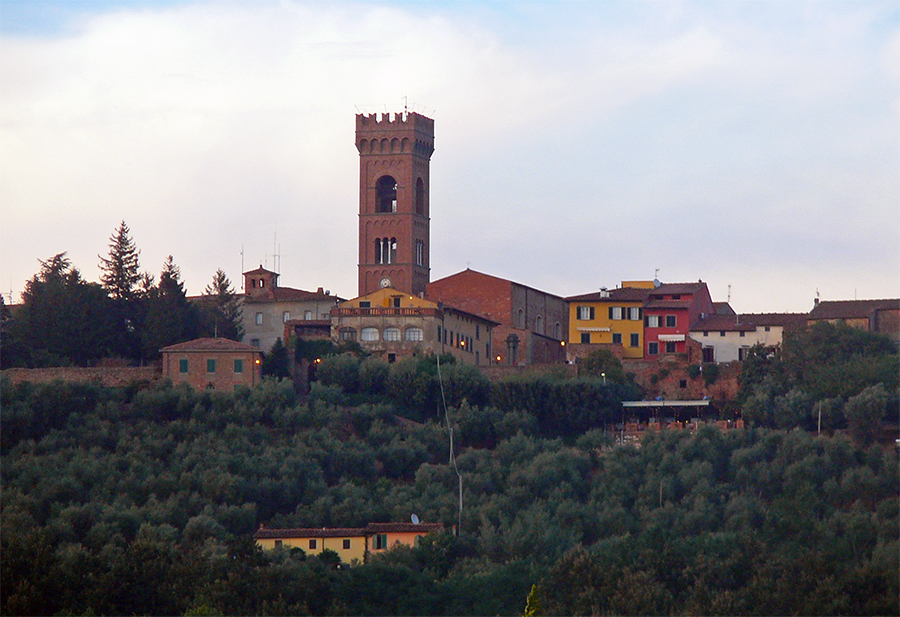
View of the beautiful Montecarlo. Photo courtesy of Wiki Commons Utente: Serendip
Poppi
I think the province of Arezzo is often overlooked by travelers to Tuscany.
This is the province to the east of Siena that contains the provincial capital of Arezzo as well as Cortona of Frances Mays’ fame (Under the Tuscan Sun).
There are loads of gorgeous towns and villages here.
Poppi sits in the gorgeous Castentino Valley and is part of the National Park of Foreste Casentinesi.
This town in Tuscany is striking from a distance with the Castle dei Conti Guidi commanding your attention.
And you’ll definitely want to check out that castle.
The construction of the “current” castle began around 1260.
Love the word “current” there. Like 1260 was just a few years ago!
Anyway…
Castle dei Conti Guidi has undergone many changes over the years — extensive renovations and expansions.
There’s a beautiful chapel in the castle — The Chapel of the Counts Guidi — that is one of the most stunning rooms in the castle.
Frescoes are also the star attraction here with the stories of the Gospels painted by Taddeo Gaddi, a student of Giotto.
And the library is spectacular with quite the collection.
Really, you won’t want to miss spending some time in this beautiful castle.
Because it’s Italy, you’ll find churches and abbeys.
And Poppi has the Romanesque Abbey of San Fedele, the Church of San Marco and the Church of the Augustinians which are all worth a quick look at the very least.
You always want to at least poke your head in the churches in Italy because you never know what beautiful piece of artwork you might see.
The Casentino region is known for its traditional menus so this means Poppi has some fabulous places to eat fresh, local food.
There are a few places to stay in town but again, this is Tuscany, so finding an agriturismo in the countryside just outside of town might be easier.
Poppi really is one of the most beautiful towns in Tuscany.
Don’t miss it!
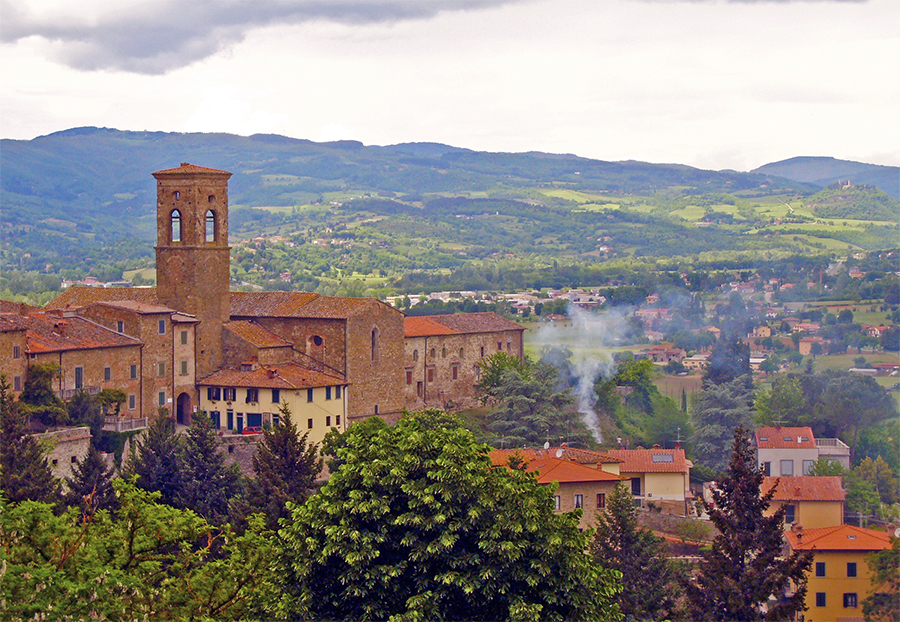
A view of the Poppi. I would love to visit this town in Tuscany. Photo courtesy of Pixabay.
Montefioralle
On my first trip to Tuscany I was, apparently, just a kilometer or 2 from this lovely Tuscan town.
I was staying just outside Greve in Chianti (a lovely spot in the Chianti region).
I’m sorry I missed it as this town in Tuscany is oozing with charm.
Montefioralle is listed as one of the most beautiful villages in all of Italy, i borghi più belli d’Italia.
This list has some gorgeous towns from all over the boot so I advise checking it out.
Anyway, here’s a fun fact about Montefioralle: It’s the reported birthplace of Amerigo Vespucci, the explorer who said that the land mass he and Columbus had landed upon was not Asia, but a new land. So the Americas were named after him.
Because this is the Chianti region this town is surrounded by vineyards and olive groves so it’s as much about the setting as it is the stone village itself.
Agnese Sabatini, a fellow travel blogger and native of Italy said this about Montefioralle:
“I think the village is at its best in autumn. Actually, there are no particular attractions here, it’s just a very nice place to have a walk along the narrow alleys.”
Walking through Montefioralle is like walking back in time. It really has maintained that old-world feel.
Naturally there is a church to visit, the Church of San Stefano, which is roughly the highest point of the village.
It’s been reconstructed a few times and now has a more Baroque style than the original Gothic style.
The single nave inside the church has some interesting art spanning across the centuries.
The defensive walls of this village are still intact.
Because it’s a tiny village, you won’t find many places to stay right in town.
Again look to the countryside for a wonderful agriturismo.
Montefioralle is a town to while away an afternoon — eating at one of the restaurants where you’ll be sharing space with the locals.
Sound like heaven to me!
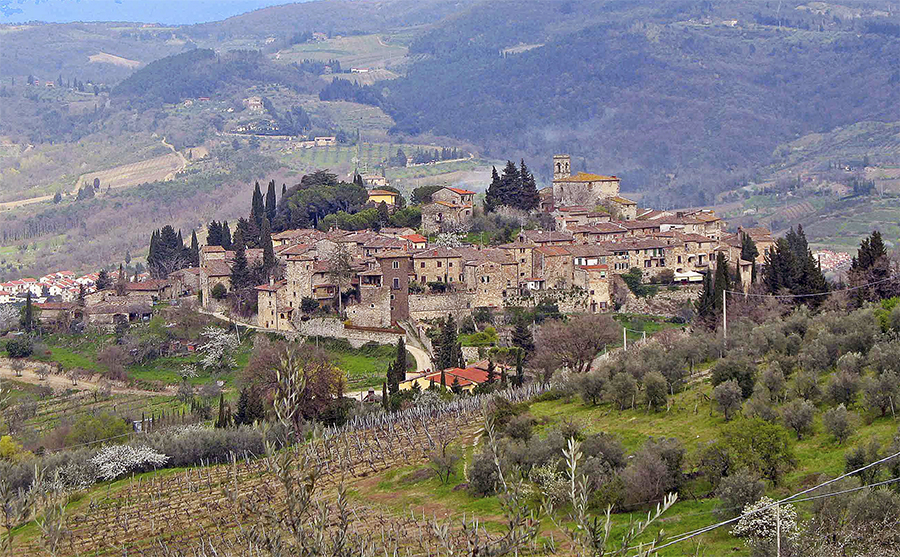
View of the stunning Montefioralle. Love! Photo courtesy of Vignaccia76 at Italian Wikipedia [Public domain], via Wikimedia Commons.
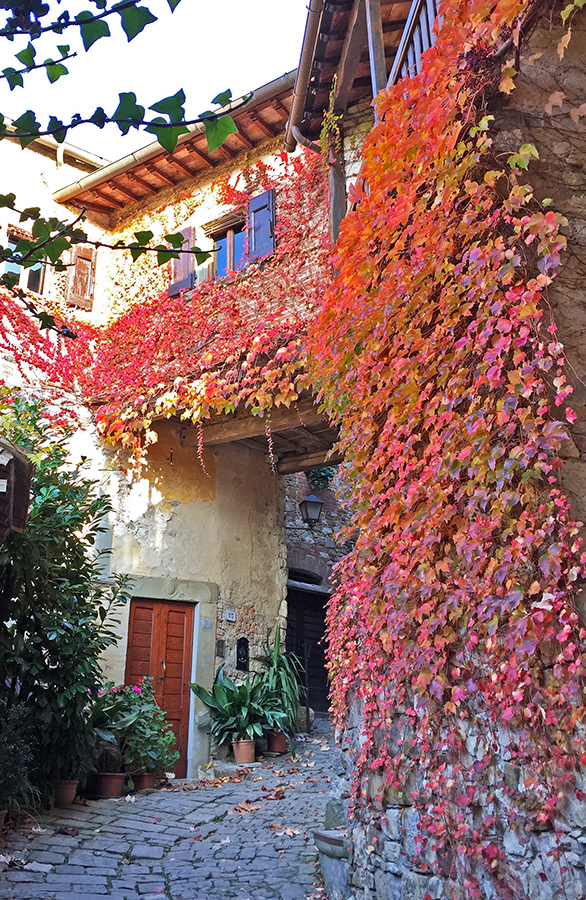
Montefioralle in autumn. A great time to visit! ©Agnese Sabatini
Suvereto
This town was also brought to my attention by Agnese Sabatini.
Suvereto is often called “the perfect Medieval hill town.”
Located 90km southwest of Florence and in the Livorno province, this town of 3100 has origins dating back to before 1000AD.
It’s a beautiful place with some interesting sites.
Here’s what Agnese Sabatini, native Tuscan, says about Suvereto:
“It embodies the real Medieval town spirit. Here you can have a walk along the alleys (you will want to take thousands of pics at every step!), and visit Rocca Aldobrandesca at the top of the town, Church of Madonna Sopra la Porta, Church of Crocifisso, the former Monastery of Saint Francis, and Pieve di San Giusto. The Town Hall building is also beautiful!”
The Rocca Aldobrandesca, now a ruins but still really cool, was built and rebuilt numerous times.
The ruling Aldobrandeschi family needed to defend their immense territories in this corner of Tuscany as Pisa, Florence and Siena were always at odds with each other.
But that ended in 1312 when the head of the family, Margherita Aldobrandesca, was beheaded.
Pisa could finally claim this land that it longed to have under its domain.
Besides the numerous sites, you’ll notice that Suvereto is located amongst thick cork, chestnut and oak woods, and Mediterranean scrub as well as grapevines and olive trees.
The area around the town is very agricultural (as is a lot of Tuscany) with olive oil mills, wineries, and agriturismi, where you can stay.
Obviously the food, wine and the olive oil are quite good!
Suvereto also hosts some wonderful traditional festivals throughout the year.
The town’s annual feast of wild boar in November is one of the highlights.
Suvereto is a town in Tuscany where history, traditions and folklore live on.
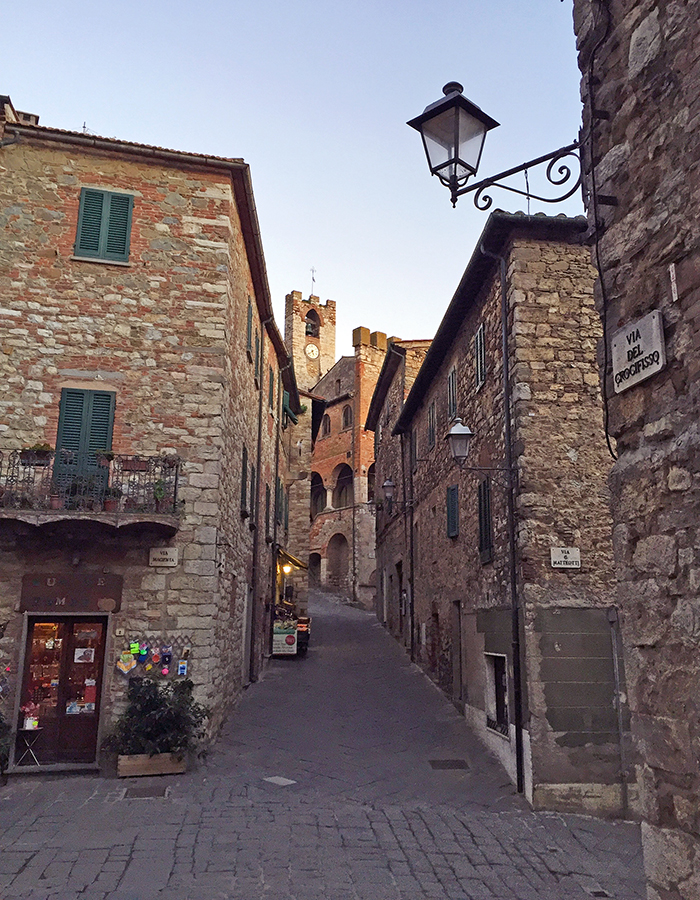
The streets of Suvereto. Looks like a fabulous place to wander around. Photo courtesy of Agnese Sabatini.
Santa Fiora
This village is located in the Maremma area of Tuscany which is well south of Florence and just south of the Val d’Orcia.
In fact, Santa Fiora lies on the southern slope of Monte Amiata.
I think this area is one of the most beautiful parts of Tuscany.
So for this town, it’s as much about the setting as the town itself.
Because for a small town there’s quite a bit to see.
The Palazzo Sforza Cesarini is one of the highlights that was built in 1571 on the ruins of an older fortress from the Aldobrandeschi family.
Two clock towers from the Aldobrandeschi still stand.
The Sforza family took over the town (and the palace) when a Sforza son married a Aldobrandeschi daughter — the whole joining 2 powerful families thing.
Anyway, the palazzo is really impressive as it was renovated throughout the 16th century.
The bottom floor is now home to the Museo delle Miniere di Mercurio del Monte Amiata.
That’s a mouthful!
This wonderful museum tells the story of the mining history and traditions of Monte Amiata and is a fabulous stop for you geology nerds out there.
Santa Fiora has its share of churches — it is Italy!
The parish church, Pieve delle Santa Flora e Lucilla, has a simple façade.
But inside you’ll find three naves and a fascinating collection of Della Robbia pottery from the 15th century.
This pottery — white, blue and green in color — sparkles.
You’ll also want to pop into The Chiesa delle Clarisse.
While the exterior might be a little ho-hum, be sure to step inside as it contains some remarkable works of art.
One of the highlights of Santa Fiora is the Peschiera which sits on the outskirts of the town.
What is it exactly?
Well, it’s a park with a man-made pond sitting in the middle of it.
It was built for the Aldobrandeschi family.
There are overgrown pine, cypress and chestnut trees around it.
And the pond is home to several species of local fish such as carp and trout.
It makes a wonderful place to sit and relax.
As is typical with so many of these small towns in Tuscany, you’ll find a few places to stay right in town, but find more choices out in the countryside.
And you’ll find some wonderful restaurants because it’s Tuscany!
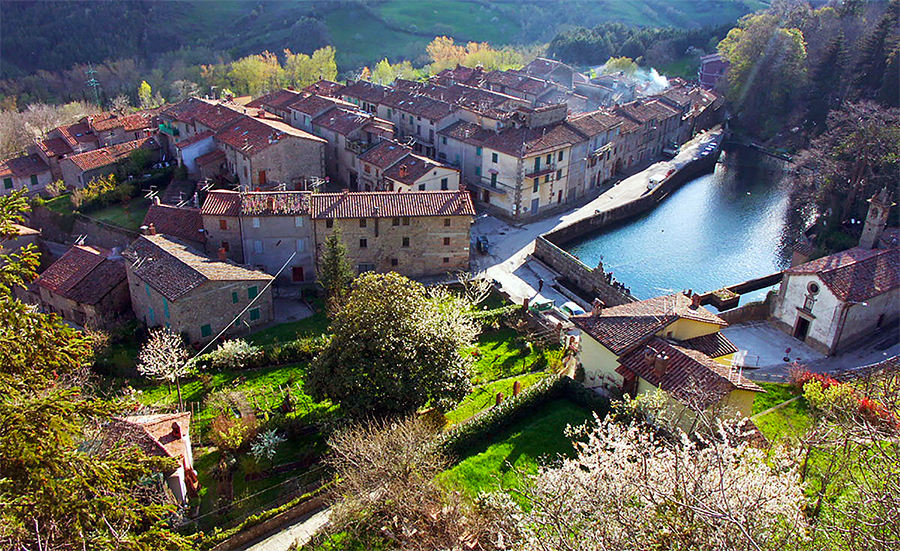
An aerial view of the beautiful Santa Fiora. Photo courtesy of Mattana [Public domain], from Wikimedia Commons
Towns in Tuscany I’ve visited
Volterra
One of the very first beautiful towns in Tuscany I traveled to is Volterra.
I think for this reason it will remain a favorite of mine.
The Etruscan city walls are still intact with 2 gates — Porta All’Arco and Porta Diana — still standing.
And it has an old Roman Theatre that is fab.
Because I tend to simply wander about with my camera, I loved finding various scenes such as these:
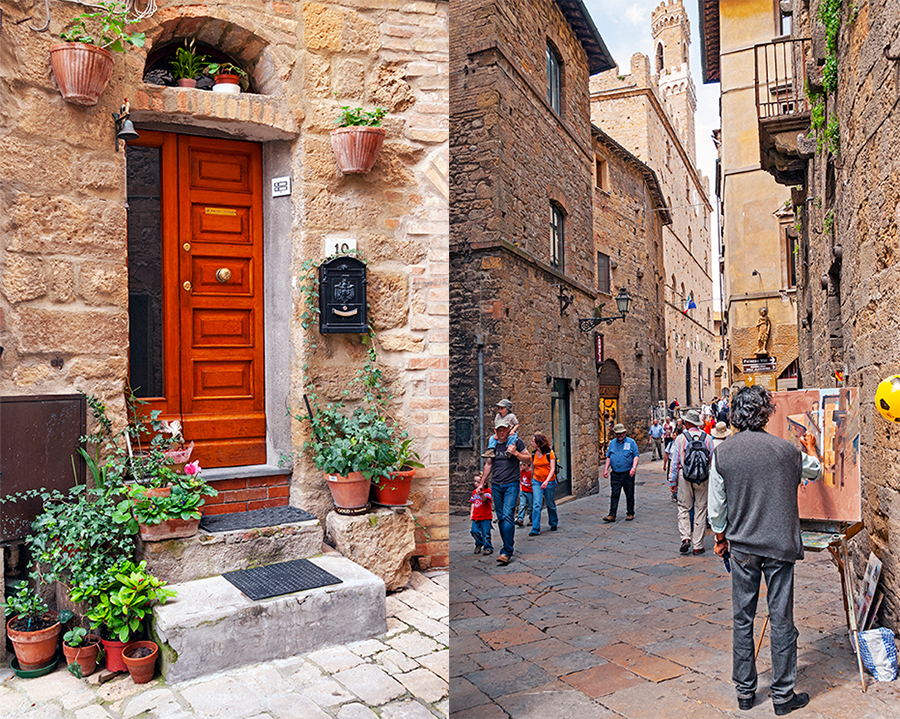
I love coming across scenes like this as I wander about a Tuscan town.
I wandered into a small chiesa, church, and into the famed Baptistery of San Giovanni.
The Duomo di Volterra is one house of worship I think I missed but be sure you don’t.
There’s a lovely park, Parco Archeologico “Enrico Fiumi”, that is a must to walk around on a nice day.
Volterra is also known for its alabaster.
You’ll find a few wonderful places to stay right in town and more agriturismi in the hills outside of town.
On my second visit to Volterra I stayed at Antico Borgo di Tignano which is a lovely agriturismo just 17km east and a place I highly recommend.
And you’ll find plenty of good restaurants serving up simple, yet delicious food.
Be sure to put Volterra on your list.
It’s a stunner.
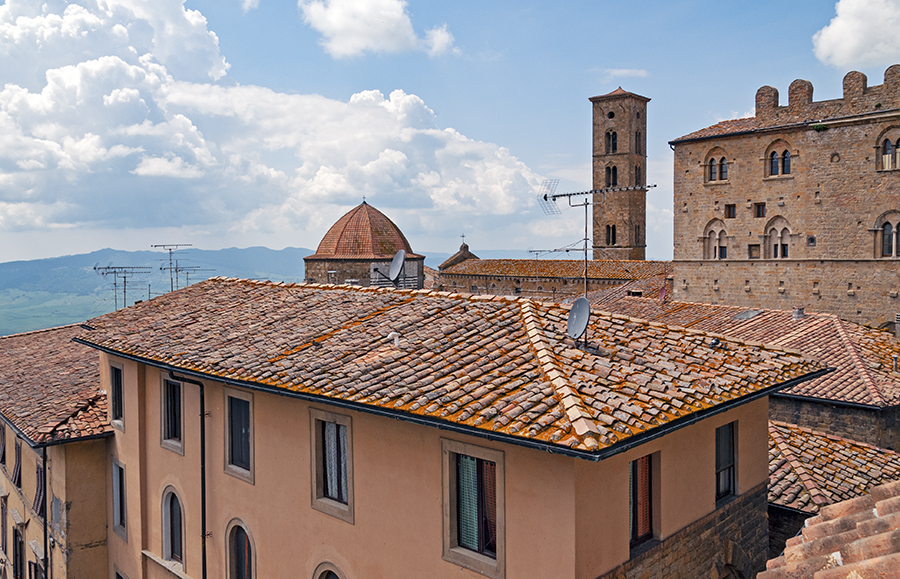
A view from my room on my first trip to Volterra. I had some nice views of the rooftops and to the Tuscan hills.
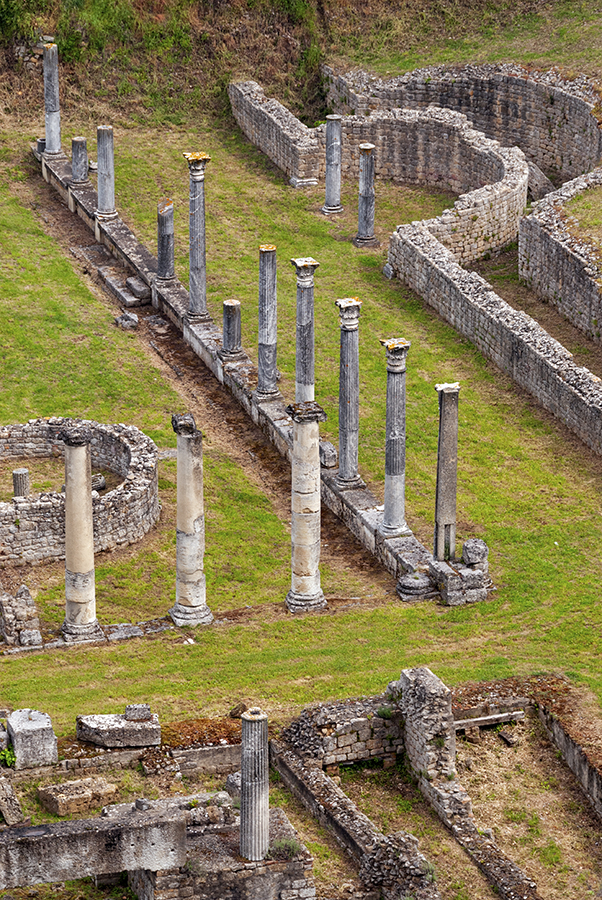
The ruins of the Roman Theatre in Volterra. Very cool!
Montalcino
Also known as the home of Brunello, Montalcino is far from being off the beaten path.
But it has more going for it than some of the best wine.
However, we will start with wine.
The vineyards around Montalcino are world-renowned, producing the stellar Brunello di Montalcino and the Rosso di Montalcino which is a step down in price but not necessarily of a lesser quality.
In Montalcino, you’ll be able to taste all kinds of wines from the area at a handful of shops. It’s great fun and a fabulous way to find wines you like.
This lovely hill town also has a Fortezza, Fortress, that you can’t miss.
You can actually do wine tastings in the Fortezza which can be a fun place to taste wine and take in some Medieval history.
There are the churches of Sant’ Agostino, Sant’ Egidio and San Francesco to check out as well.
But wander around this town, getting away from the center and you’ll be treated to slow Tuscan life and stunning views of the surrounding hills and valleys.
While there are places to stay right in town, I’d recommend finding an agriturismo out in the hills. There are quite a few around ranging from luxury to simple.
My favorite restaurant in town is Taverna del Grappolo Blu. Tasty!!
Montalcino is truly is one of the best towns in Tuscany.
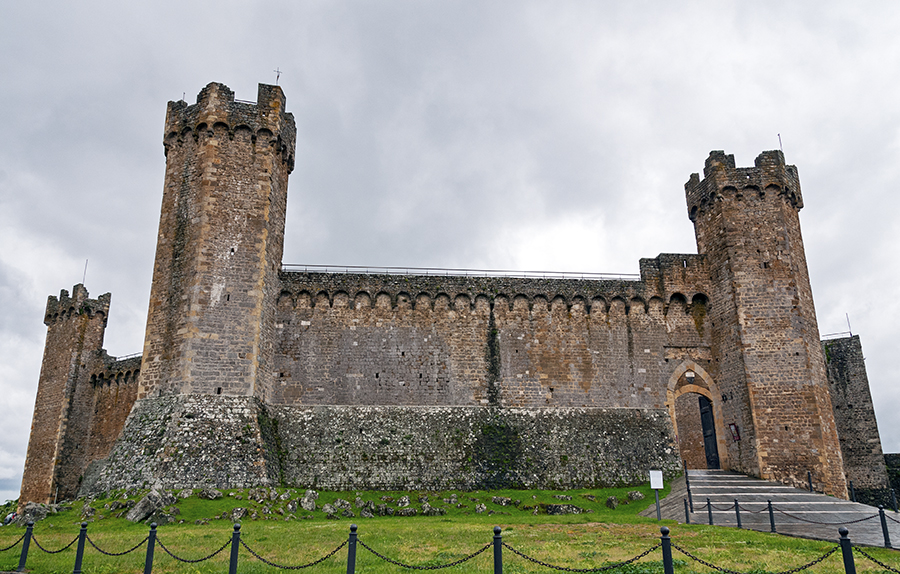
The Fortezza is a must see site and a wonderful place to try some of the delicious Brunello wines.
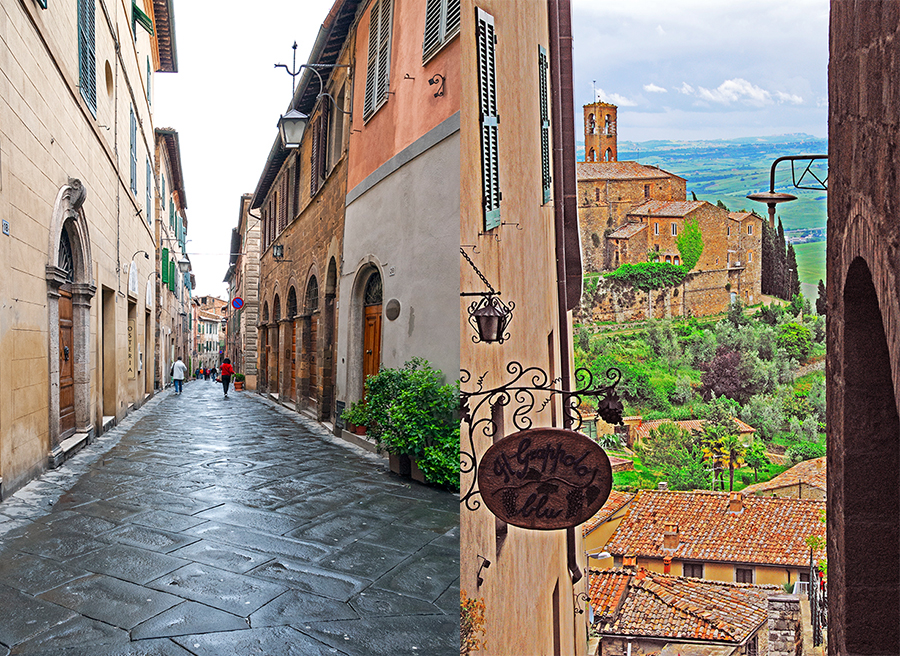
Street scene and the sign for my favorite restaurant in Montalcino.
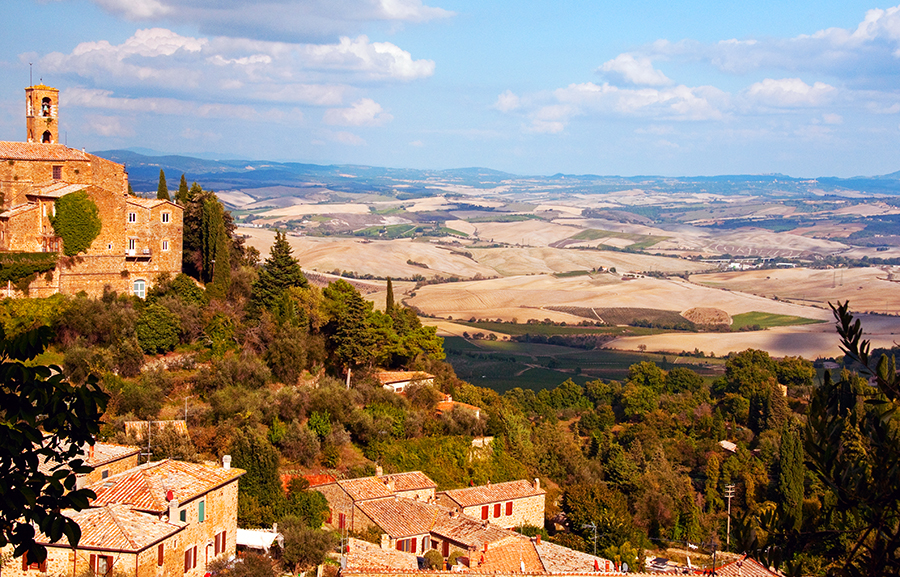
A view of Montalcino and the Tuscan countryside. Gorgeous!
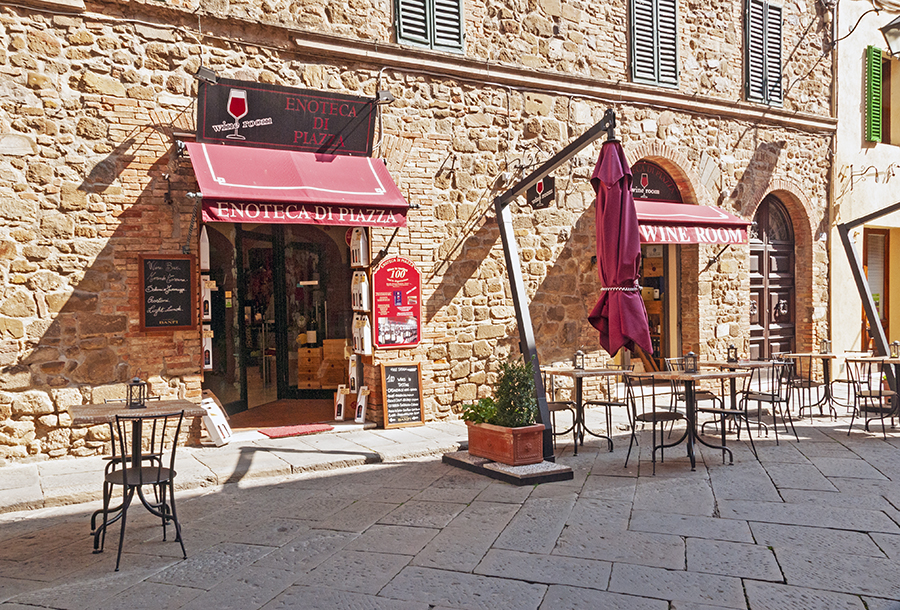
One of a few wine shops you’ll find in Montalcino. These are great places to taste the Brunello and other Tuscan wines.
Montelpulciano
Out of all the towns in Tuscany, I think this is my favorite — at least so far.
I can’t put my finger on why this is as it’s firmly on the tourist track.
But Montepulciano always shows me another layer each time I visit — which is now 3 times.
The first time was a quick one nighter in the rain that left me wanting more.
On my second visit I felt I really got to know it better as I stayed just 1km out of town —walkable to town — at Fattoria San Martino (highly recommend).
This is truly a hill town with lots of hills so being in shape helps!
There are some beautiful piazzi, town squares, to sit and people watch as well as overlooks with views across the Tuscan vineyards, hills and mountains.
Montelpulciano has some churches to see such as Sant’Agostino and Oratorio della Misericordia as well as civic buildings like Tarugi palace, the Contucci palace and the 14th century Palazzo Municipale.
The Vino Nobile di Montepulciano wine is a must for those who love vino.
Its little sister, the Rosso di Montepulciano isn’t bad either!
There are numerous shops around town to give these wines a taste.
And I found quite a few shops specializing in arts and crafts — from potters to mosaic creators to makers of leather goods.
I love seeing the Italians creating their works of art right there.
Supporting these talented folks is so important.
This Tuscan hill town doesn’t have loads of places to stay right in town.
But the area around it has a lot to choose from.
And the restaurants?
Outstanding and plentiful!
I’m a fan of Godimento di Vino but there are loads of great places to choose from to fit all budgets.
For me, I just love wandering around this town with my camera and capturing moments while getting a good workout.
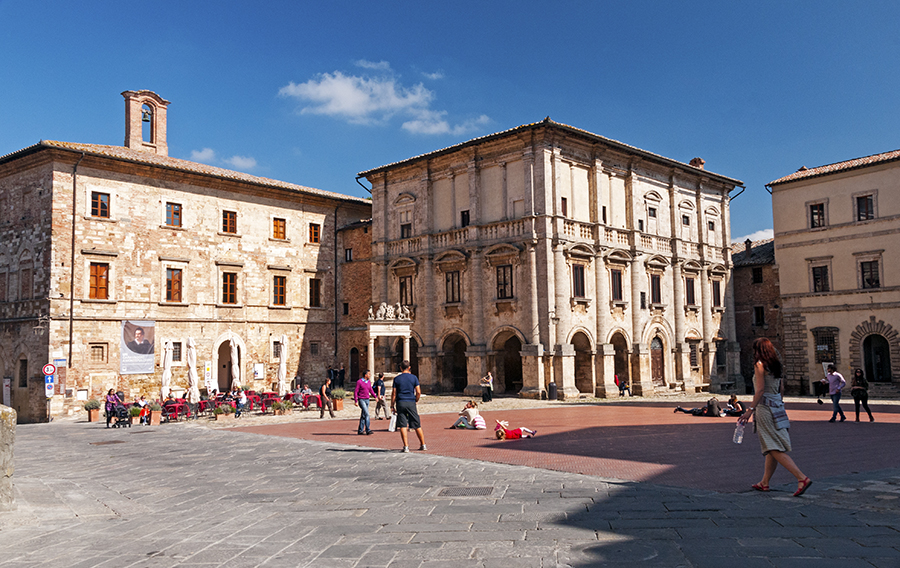
Beautiful Montepulciano!
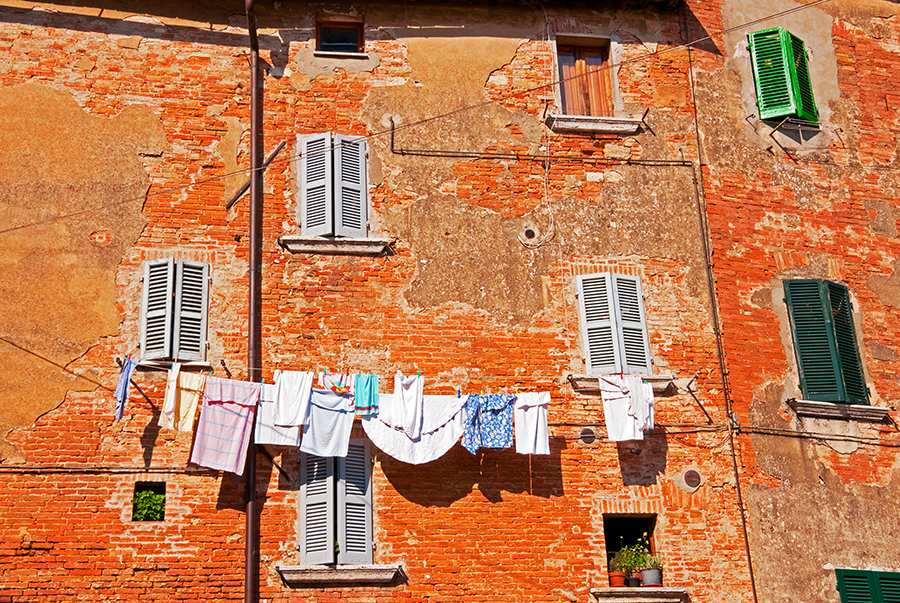
Wandering around Montepulciano with my camera led me to scenes such as this. Just love it!
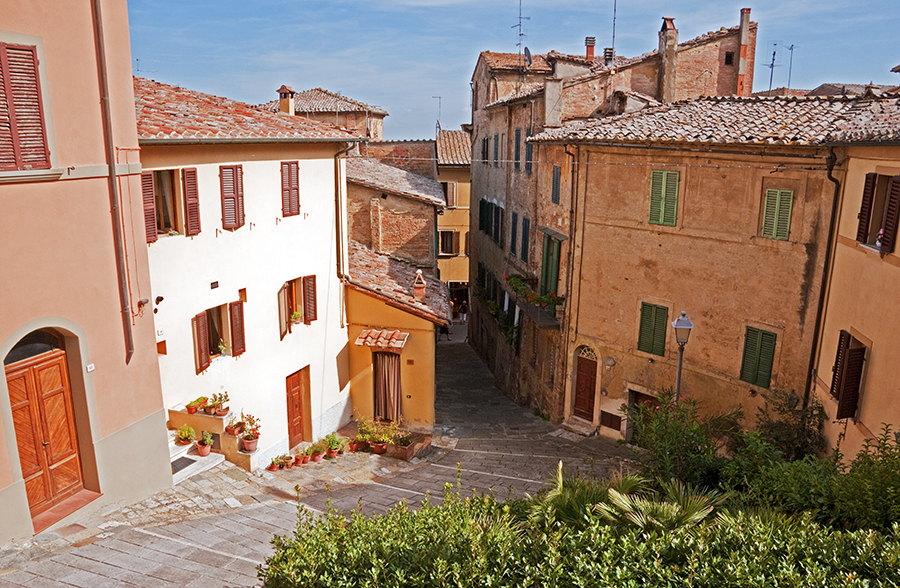
This is the view from the Godimento di Vino terrace. It’s tucked away in a lovely spot. And the food and wine are fab!
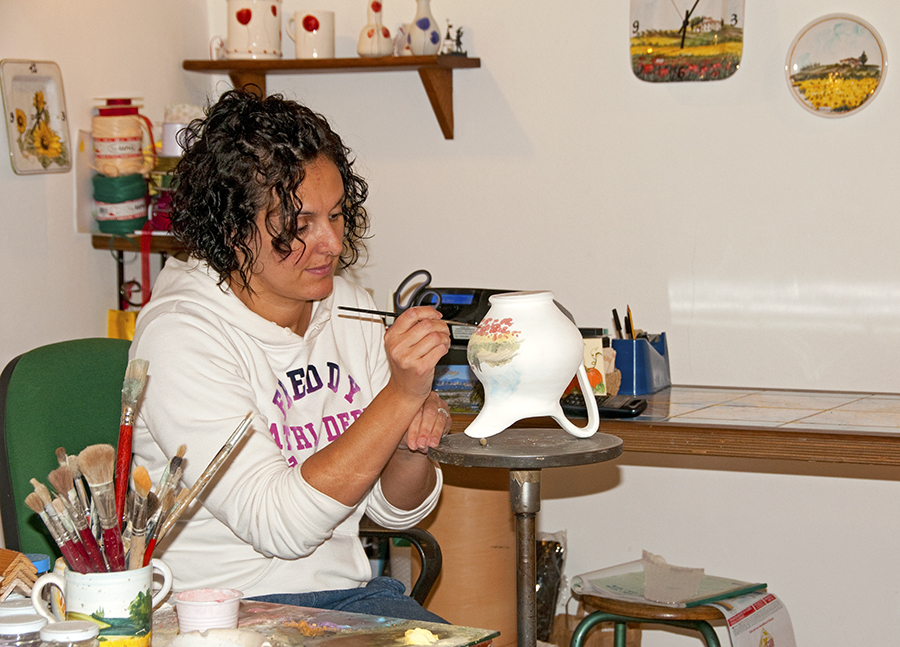
I loved seeing the craftspeople in Montepulciano as they worked on their art. This woman has some beautiful work.
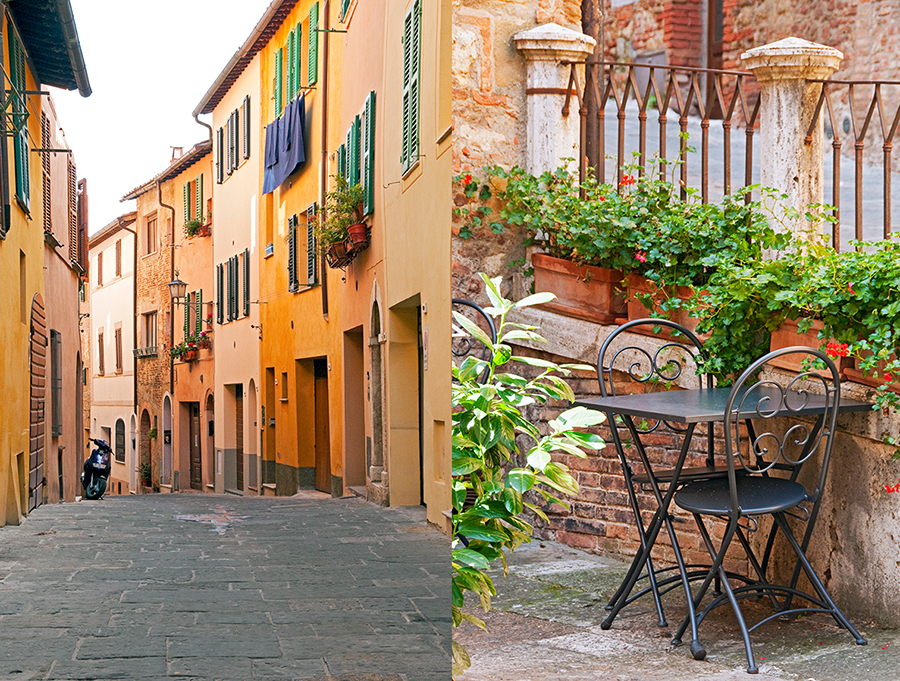
Wandering around Montepulciano with my camera led me to scenes such as this. Just love it!
Pitigliano
One of the towns located in the southern part of the region this town in Tuscany is a bit different from the others.
While many of the towns in Tuscany are hill towns this one sits more on a cliff.
The setting is quite dramatic and actually a bit more typical of the towns in this area.
I only had one full day here but I found this town to be filled with historical sites and a perfect place to wander with my camera.
Pitigliano is mostly known for its Jewish quarter and its Etruscan history.
Naturally, you’ll find some remnants of Medieval and Renaissance times.
This town was a haven for Jews back in the 14th century.
These people were integrated and welcomed in Pitigliano and had a thriving community.
Now there are no Jewish folks living here, but the memories live on as you wander about the old town and take in the plaques telling of the history.
And the synagogue still exists.
Naturally there are a few Catholic churches to pop into — Santi Pietro e Paolo Church and Santa Maria — and you can’t miss Porta Sovana, the town walls, the Palazzo, the Fortress Orsini and the aqueduct.
For fans of Etruscan history don’t miss the Civic Archaeological Museum of Pitigliano.
I wish I had visited this.
Next time!
Like most of the towns in Tuscany, you’ll find a few places to stay in town with more offerings out in the rural landscape.
Because my agriturismo had a restaurant that had fab food I didn’t eat in town.
But I saw a quite a few spots in town that looked (and smelled) delish.
I really think this part of Tuscany gets overlooked but deserves to be explored.
There’s a lot here!
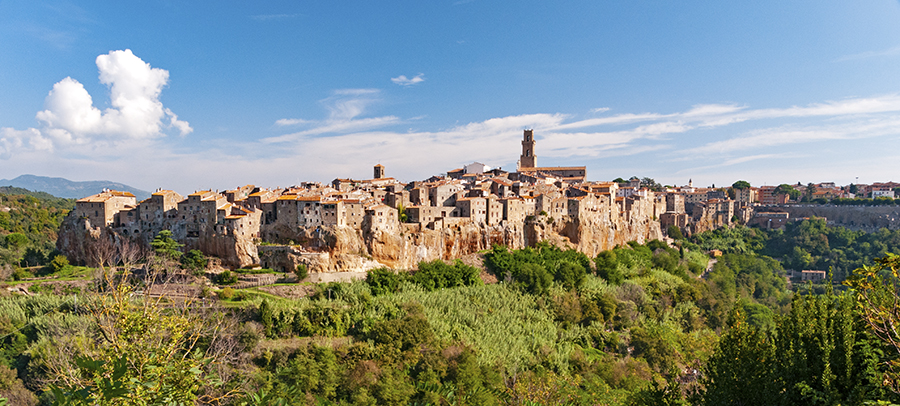
Pitigliano is just breathtaking!
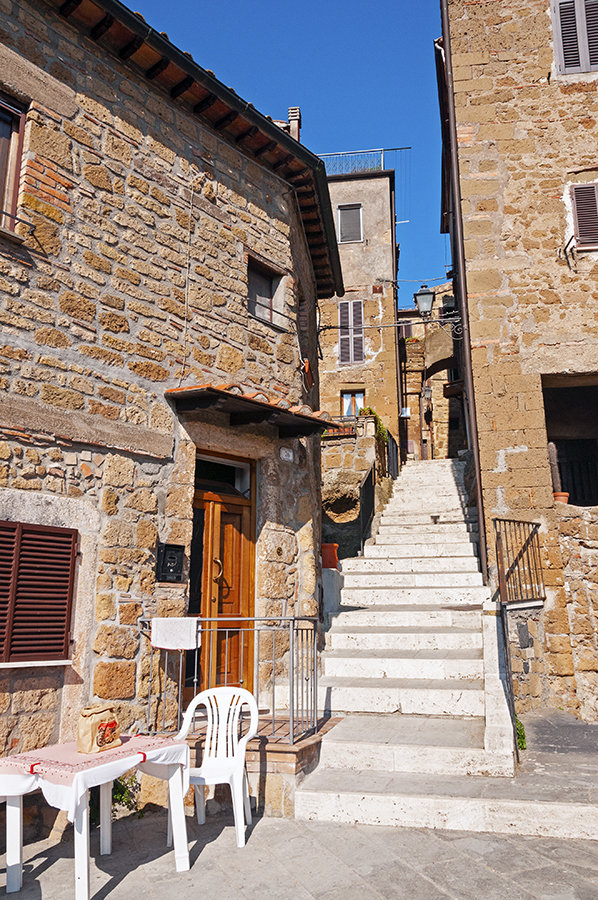
Wandering around Pitigliano is such a wonderful way to get to know the town — and see how the locals live.
Castiglione d’Orcia
This little town in Tuscany is not far from Montalcino, Pienza and Montepulciano.
And, to be honest, there’s not much here.
But somehow I still love it.
I think because it’s truly Italian.
You’re not wandering about with other tourists.
You actually get to witness — and even be a part of — true Italian life.
Piazza il Vecchietta is the main town square and home to the superb Palazzo del Comune and a few other medieval buildings.
The impressive Rocca di Tentennano is just 1km from the center of town — and hard to miss.
Castiglione d’Orcia is not a town for those seeking out loads of sites.
However, it is a town for those who want to see a real town in Tuscany — where every day life goes on.
The best places to stay are in the Val d’Orcia as you’ll find a splendid selection of agriturismi from the simple to the more luxurious.
As far as restaurants, you’ll find a few places in town that will serve up simple, fresh Tuscan fare.
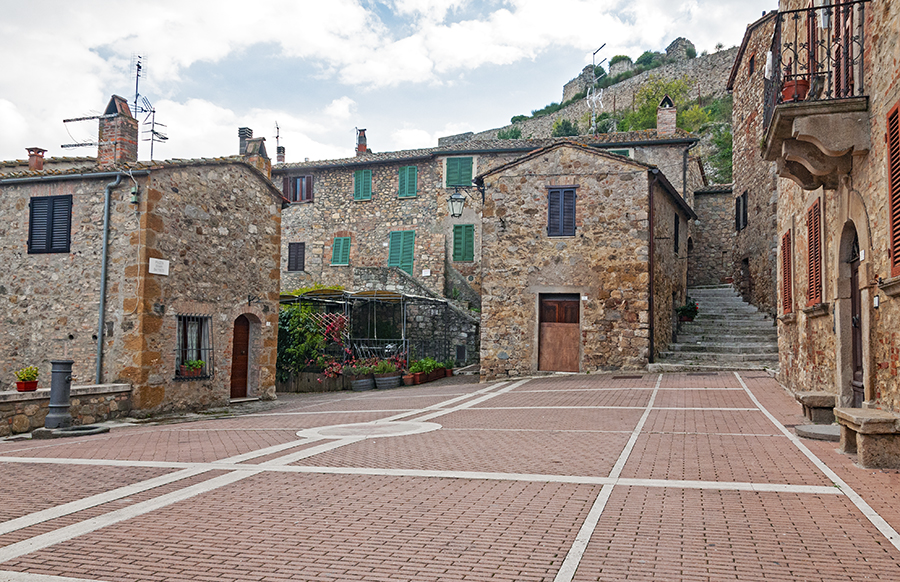
The town of Castiglione d’Orcia is one of those beautiful Tuscan towns that not many folks visit. But maybe you should!
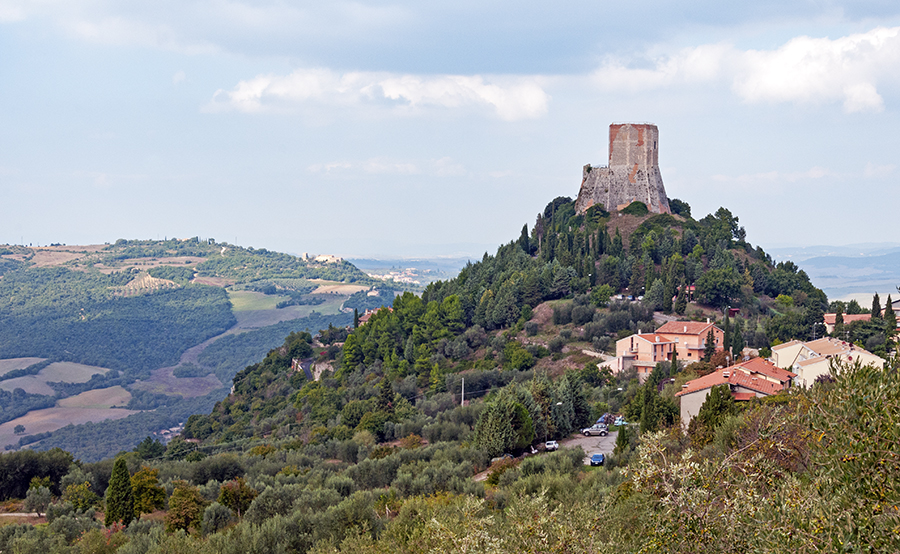
You can’t miss Rocca di Tentennano which is just a 1km walk from town.
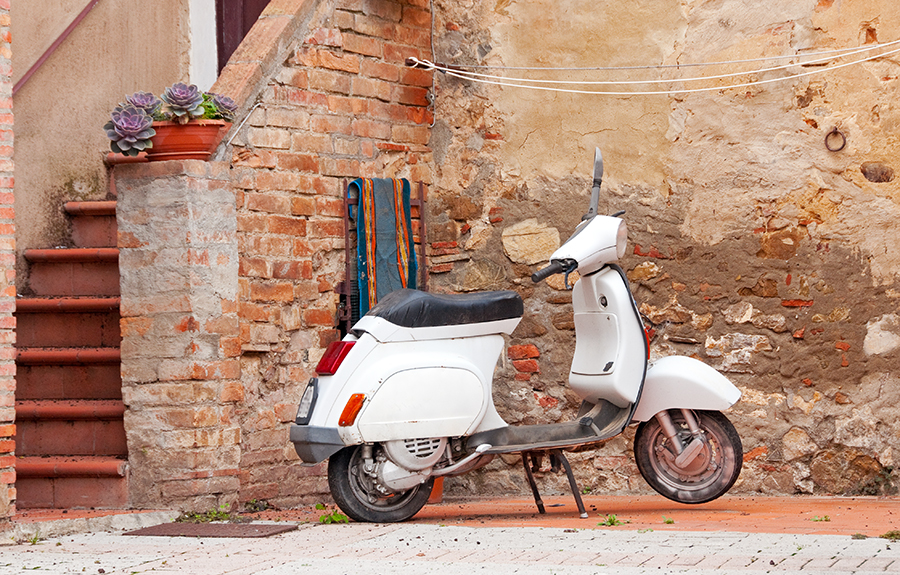
Wandering around leads me to every day life scenes like this one in Castiglione d’Orcia.
Bagno Vignoni
This is a tiny Tuscan hamlet that has all of about 30 people living there.
But it’s quite popular because of its hot springs.
So instead of a piazza in the center of town you’ll find a pool.
Okay, so this isn’t the pool you’ll be soaking in as that pool is at the Parco dei Mulini which is just below town.
It’s here that you can relax in a spring of naturally hot water.
And from what I can tell it’s free!
I stopped for a brief walk around Bagno Vignoni and really wish I had spent a bit more time here.
There aren’t a lot of places to stay but there are nearby.
I did spot a few restaurants that had some delicious offerings on their menus.
Bagno Vignoni is a perfect spot to slow down.
It’s tranquil, picturesque and unique.
I’d definitely be sure you put it on your list.
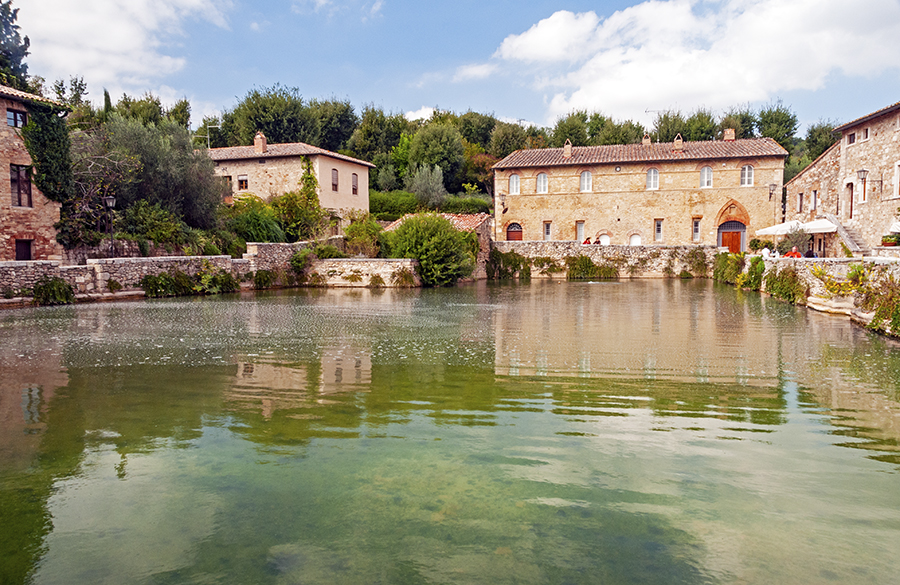
The beautiful Tuscan hamlet of Bagno Vignoni.
Casole d’Elsa
Otherwise known as the town “over there” when I was staying at Antico Borgo di Tignano, Casole d’Elsa stole my heart.
This is one of the most beautiful towns in Tuscany, in my opinion, and it truly surprised me.
It’s close to San Gimignano and not too far from Volterra.
Casole d’Elsa’s walls are still intact as are a couple of towers.
This is definitely a town for artists as it’s the home to the world-renowned Verrocchio Art Centre which offers fine art courses, painting holidays, and sculpture courses.
And you’ll find sculptures around town which I loved!
The Church of San Niccolo and the Collegiata di Santa Maria Assunta are worthy of some time.
And the views out to the Val d’Elsa are stunning.
While there are very few places to stay in town, you’ll find plenty of places to eat.
Stay in the countryside in a spot like Antico Borgo di Tignano.
The best part of this town is, again, being part of Italian life.
I remember wandering around and watching parents walking their children home from school, stopping at the gelato shop.
I watched as folks sat outside a cafe and chatted.
It was very real to me.
And that’s one of the joys of travel for me.
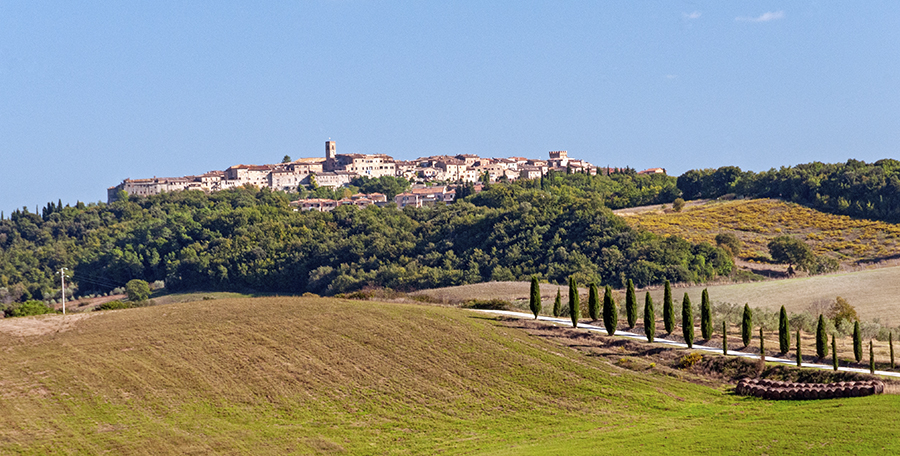
The town “over there” is Casole d’Elsa. This was the view of it from Antico Borgo di Tignano where I stayed. I just had to go see what this town was all about — and so glad I did!
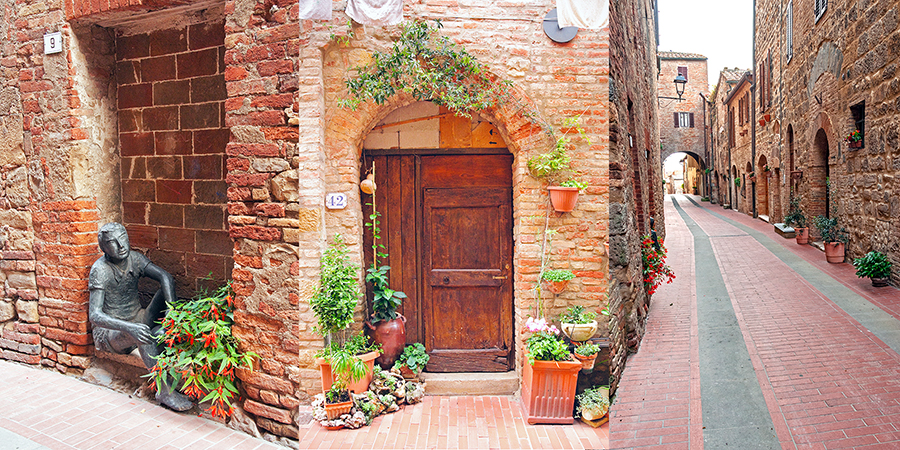
Meandering the streets of Casole d’Elsa is awesome! From sculptures to doorways to lovely pedestrian ways. I love this town!
So there you have some of the most beautiful towns in Tuscany
Did one or 2 capture your attention?
I hope so.
There are many more to choose from.
My advice, especially if you are seeking some lesser visited towns, is to put some of the typical guidebooks away.
Look at Google maps and see what villages pop up.
It’s hard to go wrong with any town in Tuscany — they’re all gorgeous.
But find one or 2 that look interesting and take a chance.
Buon Viaggio!
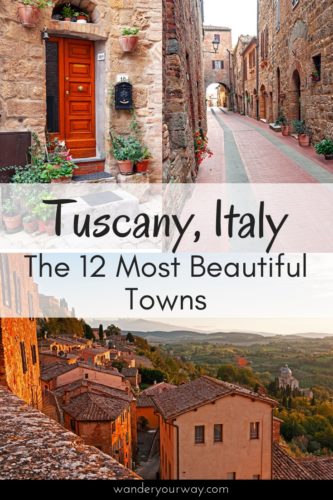

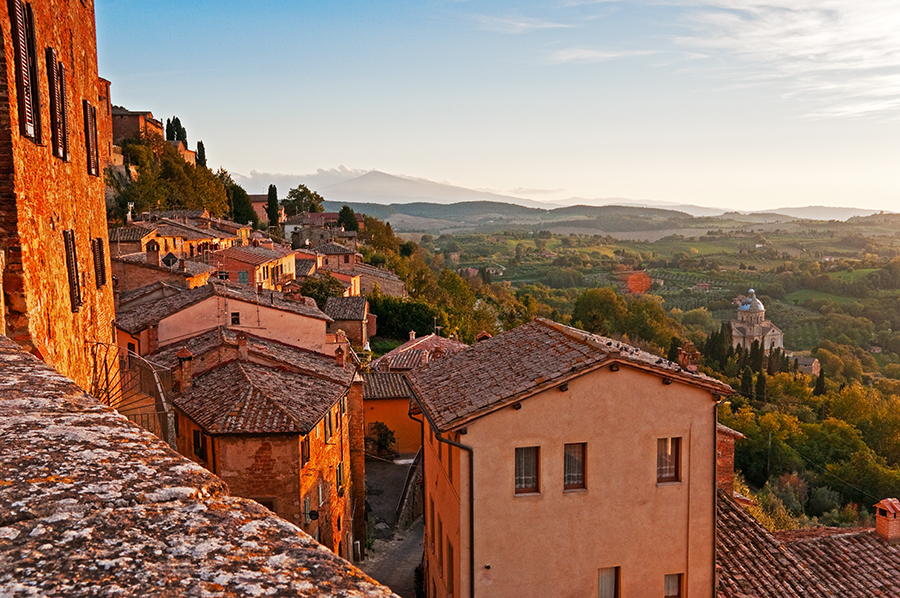







Your photos are absolutely stunning. I especially love the one of the man painting in the street. Also – very thorough breakdown of where to go in Tuscany… I’ll be saving this for the day I get to go!
Thanks, Katie. I really like the image of the man painting too! Do get to this part of Italy. It’s really stunning (and the food is delicious)!!
Planning to go to Tuscany so this comes in quite handy – thanks a lot! Your recommendations are just so good. Such a well written post.
Thanks, Pau. You will love it there. My recommendation is to mix in a couple of the more well-known towns with some others that are a bit off the tourist trail. You really can’t go wrong!!